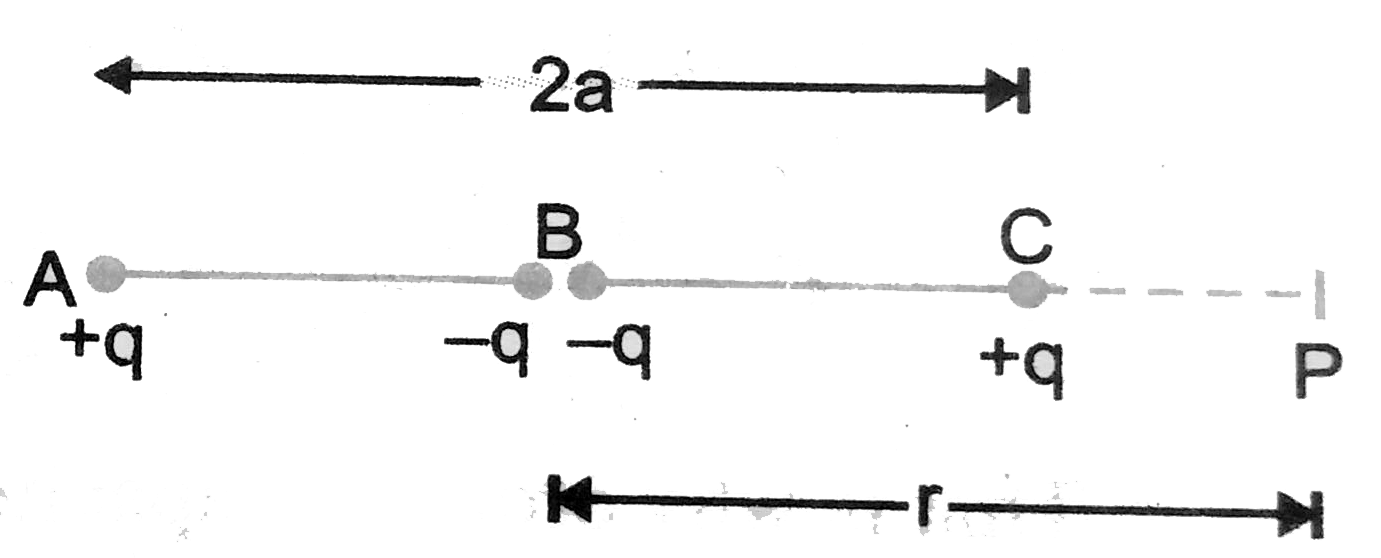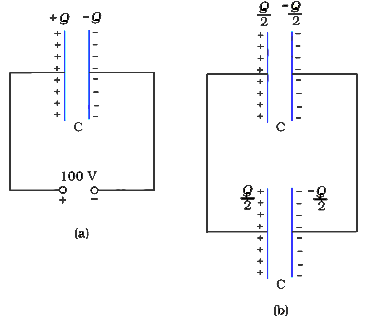Figure shows a charge array known as an electric quadrupole. For a point on the axis of the quadrupole, obtain the dependence of potential on 'r' for ra>>1, and contrast your result with that due to an electric dipole, and an electric monopole (i.e, a single charge)  Solution in Tamil
Solution in Tamil
For large r, quadrupole potential goes like 1/r3, dipole potential goes like 1/r2 , monopole potential goes like 1/r.
Topper's Solved these Questions
- ELECTROSTATIC POTENTIAL AND CAPACITANCE BOOK - NCERT TAMILCHAPTER - ELECTROSTATIC POTENTIAL AND CAPACITANCE EXERCISE - ADDITIONAL EXERCISES
1 Videos
- ELECTROSTATIC POTENTIAL AND CAPACITANCE BOOK - NCERT TAMILCHAPTER - ELECTROSTATIC POTENTIAL AND CAPACITANCE EXERCISE - ADDITIONAL EXERCISES
1 Videos
- ELECTROMAGNETIC WAVESBOOK - NCERT TAMILCHAPTER - ELECTROMAGNETIC WAVESEXERCISE - Evaluation (Numerical problems)
5 Videos
- ELECTROSTATICSBOOK - NCERT TAMILCHAPTER - ELECTROSTATICSEXERCISE - Exercises
23 Videos
Similar Questions
A charge of 8 mC is located at the origin. Calculate the work done in taking a small charge of −2×10−9C from a point P (0,0,3 cm) to a point Q (0,4 cm, 0) via a point R (0,6 cm, 9cm).
View SolutionA charge of 8 mC is located at the origin. Calculate the work done in taking a small charge of −2×10−9C from a point P (0,0,3 cm) to a point Q (0,4 cm, 0) via a point R (0,6 cm, 9cm).
View SolutionConsider a parallel plate capacitor whose plates are closely spaced. Let R be the radius of the plates and the current in the wire connected to the plates is 5 A, calculate the displacement current through the surface passing between the plates by directly calculating the rate of change of flux of electric field through the surface.
View SolutionWhen two objects are rubbed with each other, approximately a charge of 50 nC can be produced in each object. Calculate the number of electrons that must be transferred to produce this charge.
View SolutionFig shows a charge array known as an 'electric quadrupole'. For a point on the axis of the quadrupole, obtain the dependence of potential on r for r/a>>1, and contract your results with that due to an electric dipole and an electric monopole (i.e, a single charge).

View SolutionFigure shows a charge array known as an "electric quadrupole". For a point on the axis of the quadruple, the dependence of potential on r(r/agt gt1) is 1/(r^(n)) . Find n ?
View Solutionनीचे दिए गए चित्र 2.32 में के आवेश विन्यास जिसे विद्युत चतुर्ध्रुवी कहा जाता है, दर्शाया गया है । चतुर्ध्रुवी के अक्ष पर स्थित किसी बिंदु के लिए r पर विभव कि निर्भरता प्राप्त कीजिए जहाँ r/a>>1 । अपने परिणाम कि तुलना एक विद्युत द्विध्रुत व विद्युत एकल ध्रुव (अर्थात किसी एकल आवेश) के लिए प्राप्त परिणामों से कीजिए ।

View Solutionनिम्न चित्र में एक आवेश विन्यास जिसे विद्युत चतुर्ध्रुवी कहा जाता है, दर्शाया गया है। चतुर्ध्रुवी के अक्ष पर स्थित किसी बिंदु के लिए r पर विभव की निर्भरता प्राप्त कीजिए जहाँ r/a>>1 अपने परिणाम की तुलना एक विद्युत द्विध्रुव व विद्युत एकल ध्रुव (अर्थात किसी एकल आवेश) के लिए प्राप्त परिणामो से कीजिए।

View Solutionचित्र में प्रदर्शित चार आवेशों का संयुक्त निकाय विधुत-चतुध्रुव (electric quadrupole) कहा जाता है । निकाय के अक्ष पर केंद्र से r दूरी पर स्थित बिंदु P पर विभव का व्यंजक प्राप्त करें , यदि ar<<1. प्राप्त परिणाम की तुलना एक विधुत-द्विध्रुव (electric dipole) एवं विधुत एकल ध्रुव (electric monopole) के कारण विभव से करें ।

View SolutionElectric potential (ϕ) of a quadrupole varies with distance 'r' on its axis as :-
View SolutionThe figure given below shows a charge array known as an 'electric quadrupole'. For a point on the axis of the quadrupole, obtain the dependence of potential on r for (r )/(a) gt gt 1 . Contrast your result with that due to an electric dipole and an electric monopole (i.e. a single charge).
View SolutionDeduce an expression for the electric potential due to an electric dipole at any point on its axis. Mention one contrasting feature of electric potential of a dipole at a point as compared to that due to a single charge.
View SolutionFigure shows a charge array known as an electric quadrupole. For a point on the axis of the quadrupole, obtain the dependence of potential on 'r' for r/a gt gt 1 , and contrast your result with that due to an electric dipole, and an electric monopole (i.e, a single charge)
View SolutionFigure 2.32 shows a charge array known as an electric quadrupole. For a point on the axis of the quadrupole, obtain the dependence of potential on r for r/a>>1 , and contrast your results with that due to an electric dipole, and an electric monopole (i.e., a single charge).

View SolutionFigure 2.32 shows a charge array known as an electric quadrupole. For a point on the axis of the quadrupole, obtain the dependence of potential on r for r//a gt gt 1 , and contrast your results with that due to an electric dipole, and an electric monopole (i.e., a single charge).
View SolutionFig shows a charge array known as an 'electric quadrupole'. For a point on the axis of the quadrupole, obtain the dependence of potential on r for r//a gtgt 1 , and contract your results with that due to an electric dipole and an electric monopole (i.e, a single charge).
View Solution
